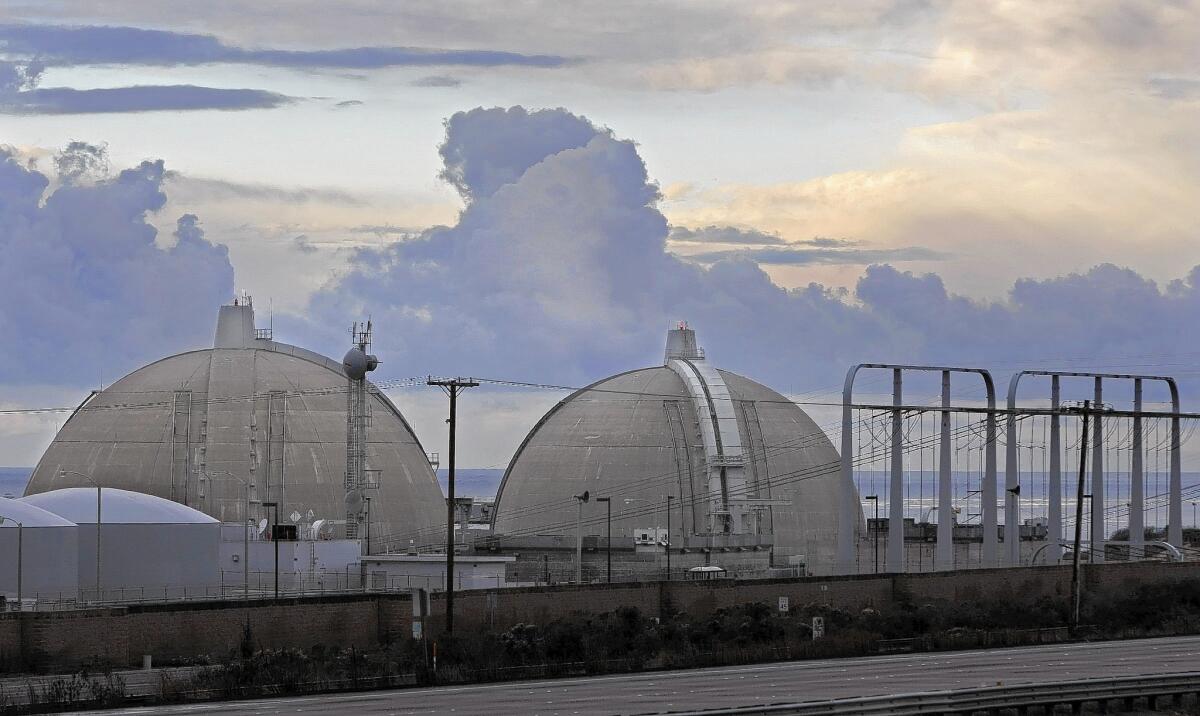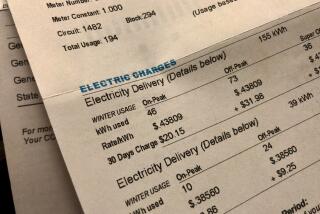Edison’s San Onofre settlement mirrors bailouts of banks

The concept of a corporation “too big to fail” is typically applied to big banks, usually as an explanation of why they haven’t been brought to book for their role in the 2008 crash and why their top executives still roam free through corporate suites and across country club fairways.
But the proposed settlement recently reached by consumer advocates and Southern California Edison over the San Onofre nuclear plant fiasco shows that utilities, too, can be too big to fail. On balance, the settlement is a good deal for Edison customers, or ratepayers. But that’s mostly by comparison to how much Edison wanted to squeeze from the ratepayers for its utter mismanagement of that monumental bust on the Pacific coast north of San Diego. (San Diego Gas & Electric was a junior partner in San Onofre and left management largely up to Edison.)
San Onofre has been permanently shuttered, at least 10 years earlier than expected, because of a botched $700-million project to replace its aging steam generators. New models were installed in 2010 and 2011 and, thanks to design flaws, misengineering, or both, showed catastrophic wear by January 2012. The plant stopped producing electricity that month, and Edison decided last year that it would never reopen.
Put simply, Edison and SDG&E wanted their customers to pay for everything, as though the transformation of an operating nuclear plant into a nonfunctioning husk were an act of God like a meteor strike, not human error. The settlement, which was negotiated by the consumer advocacy group TURN and the Public Utilities Commission’s Office of Ratepayer Advocates, relieves customers of about $1.4 billion of the $4.7 billion the utilities had wanted to keep collecting.
The settlement calls for shareholders largely to eat the cost of the defective steam generators — more than $1 billion the utilities otherwise wanted to continue charging customers from 2012 through the mid-2020s, as well as an additional $110 million spent in 2012 in a failed attempt to get the units operational again. Ratepayers also will share in any compensation the utilities receive from claims they are filing with their insurer and the generators’ builder, Mitsubishi Heavy Industries, and will be credited with 95% of the revenue from sales of unused reactor fuel.
The parallels between the financial crisis and the San Onofre crisis are striking. Both events involve big companies that acted heedlessly and stuck the public with much of the cost.
Here’s another parallel: Like the bankers and Wall Street executives who fomented the crisis and the Great Recession, the top executives of Edison are mostly still in place, and have done mighty well out of the wreckage. According top public disclosures, Edison International Chairman and Chief Executive Theodore Craver — who has been in charge since mid-2008 — exercised stock options for more than 172,000 shares and pocketed $4.1 million in proceeds, a few days after the settlement was announced. (Edison says the timing of Craver’s transaction was dictated by regulatory rules governing his option exercises. In 2013, while the San Onofre crisis was unfolding, Craver also got a bump in salary and incentive compensation to $6.6 million from $6.43 million.
The deal is subject to approval by the PUC, which will scrutinize it over the next several months; a public meeting will be held June 16 in Costa Mesa. The commission may require some tweaks in the terms, but early indications are that it is likely to sign off.
Yet there’s plenty to dislike about the deal. For one thing, the PUC would end its investigation of Edison’s management of the generator replacement, including the degree to which it neglected oversight of the steam generators’ design and manufacture. That could be important because Edison, while no longer operating a nuclear plant, is still very much a nuclear utility — 2,600 highly radioactive spent fuel rods are resting in pools on the San Onofre site, to be managed by Edison possibly for decades.
“There’s a big problem about ending review of all of this,” says Daniel O. Hirsch, a lecturer on nuclear policy at UC Santa Cruz. “They continue to have 10 Chernobyls’ worth of long-lived radioactivity in their spent fuel pools, and to the extent they cut corners badly on the steam generators you would want to learn those lessons. That is not happening.”
The anti-nuclear group Alliance for Nuclear Responsibility argues further that the settlement precludes examination of the shutdown’s ripple effects on electricity and environmental costs statewide, not merely on power supplies in Southern California. Those effects include the cost of excess carbon dioxide emissions from the burning of coal to replace San Onofre’s output, says John Geesman, the group’s attorney and a former California energy commissioner. He cites a study by the Energy Institute at UC Berkeley’s Haas School of Business, which calculates the increased emissions as the equivalent of putting 2 million more cars on the road, with an implied cost of $320 million a year.
To the consumer advocates who negotiated the settlement, these policy goals might be met only in a perfect world — not one in which Edison was prepared to delay endlessly and spend lavishly in a legalistic fight for its existence.
“We basically got the outcome we had already laid out as our key litigation position,” says Matthew Freedman, an attorney for TURN. That position called for an end to charging ratepayers for the defective units as of Feb. 1, 2012. “That’s the big win for ratepayers.” (Ratepayers had already been charged roughly $200 million for the 20 months or so that the generators were functional; the utilities get to keep that.)
Utility customers might have gotten more if the case went to court — but maybe not. “The game Edison wanted to play is to say they didn’t make any mistakes — it was Mitsubishi that made the mistakes,” Freedman says. Although federal nuclear regulators have already ruled that Edison was responsible, there was still a risk that Edison might be able to demonstrate in court that it met the state’s standards for prudent operations — and therefore that ratepayers should be on the hook entirely for the disaster.
It’s not worth the effort to stretch out the process in hopes of finding a smoking gun proving Edison’s incompetence, he says. “Although it might be satisfying to figure out who at Edison knew what and when, for us it’s about money for ratepayers.”
The lessons of San Onofre are stark. In retrospect, it is crystal clear that Southern California Edison should never have been entrusted with a project as complex as a nuclear power plant. For almost all its history, which dates to 1968, the plant has been bedeviled by lax management and constant safety problems; the shutdown is only one more chapter in a grim chronicle.
But this is true of almost the entire nuclear power industry. America’s nuclear utilities have survived over the last six decades only with billions of dollars in government handouts and the sufferance of indulgent state and federal regulators. They have failed to win the confidence of the American public, with good reason.
“The nuclear power industry is remarkable in its lack of belief in the free market system,” Hirsch says. “When they have to pay, they generally don’t want to pay.”
Indeed, not long after mothballing San Onofre last year, Edison began arguing that its shareholders should be “made whole” for their entire investment in the plant, leaving customers to bear all the burden of its incompetence.
The negotiators from TURN and the Office of Ratepayer Advocates managed to walk Edison back by more than $1 billion, but there was little they could do to keep the same utilities that mismanaged San Onofre from overseeing the radioactive facility’s future. That could be the next 60 years or so, the time needed to dismantle the plant and restore the landscape to pristine condition. The costs of the San Onofre adventure are far from over.
Michael Hiltzik’s column appears Sundays and Wednesdays. Read his blog, the Economy Hub, at latimes.com/business/hiltzik, reach him at mhiltzik@latimes.com, check out facebook.com/hiltzik and follow @hiltzikm on Twitter.
More to Read
Inside the business of entertainment
The Wide Shot brings you news, analysis and insights on everything from streaming wars to production — and what it all means for the future.
You may occasionally receive promotional content from the Los Angeles Times.











